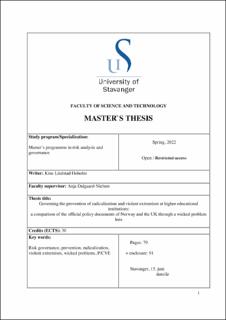| dc.description.abstract | The increasing attention accorded to radicalization and violent extremism (RVE) has resulted
in higher educational institutions finding themselves at the forefront of counterterrorism
strategies. In recent years, both Norway and the UK have implemented official policies
targeting the prevention of RVE in this sector. However, implementing policies on the
prevention of RVE is not problem-free. It is often viewed as a tantamount to a wicked policy
problem as there exist high degrees of knowledge gaps, conflicting values and interests, and
various stakeholders with differing priorities and tasks. This challenge is also reflected in the
two policies. Despite similar aims, their reception varied substantially as the UK policy has
been subject to considerable criticism on its potential to endanger educational functions and
societal freedoms. This thesis compares and examines the two policies to extract knowledge on
their functioning and to explore why they were met with such differing receptions.
The policies´ are examined and compared regarding their risk governance strategy and through
a theoretical framework building on wicked problems and governance theory. As the
effectiveness of prevention concerning its possibilities to reduce RVE is inevitably unknown,
the processes and management aspects of the policies illuminate knowledge on their
functioning and implications on P/CVE in higher educational institutions. Three key principles
for governing wicked problems are thus identified to frame a comparative document analysis.
The findings in this research point to similarities and vital differences regarding the risk
governance strategies identified within the two countries´ official policy documents. These
differences also result in them aligning with insights on governing wicked problems to various
degrees. The Norwegian strategy is found to align with research to a high degree, while, the
UK policy seems to only reflect research to some degree. Findings also showed that this results
in the Norwegian policy offering better pre-requisites for approaching P/CVE at higher
educational institutions. The findings also point to the identified differences in the strategies
representing a plausible, partial explanation for the criticism targeted towards the UK policy.
Consequently, the findings suggest an ought awareness on risk governance strategies as they
are not insignificant for how the P/CVE at higher educational institutions unfolds.
Simultaneously, more situational research is called for to acquire a broader and a more holistic
picture of the policies and their belonging practices. | |
